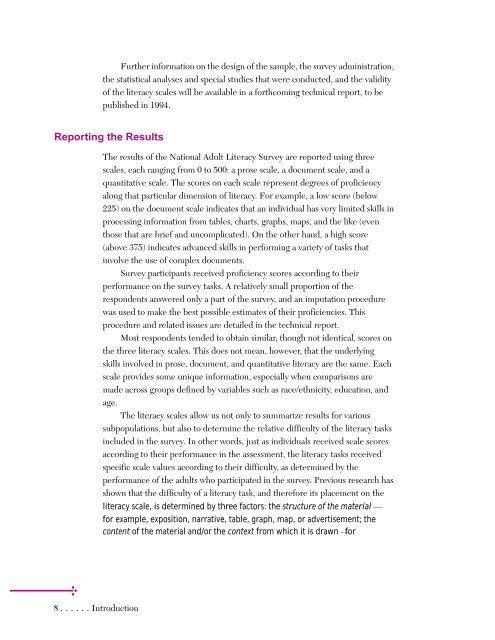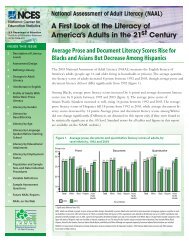Adult Literacy in America - National Center for Education Statistics ...
Adult Literacy in America - National Center for Education Statistics ...
Adult Literacy in America - National Center for Education Statistics ...
You also want an ePaper? Increase the reach of your titles
YUMPU automatically turns print PDFs into web optimized ePapers that Google loves.
8 ......Introduction<br />
Further <strong>in</strong><strong>for</strong>mation on the design of the sample, the survey adm<strong>in</strong>istration,<br />
the statistical analyses and special studies that were conducted, and the validity<br />
of the literacy scales will be available <strong>in</strong> a <strong>for</strong>thcom<strong>in</strong>g technical report, to be<br />
published <strong>in</strong> 1994.<br />
Report<strong>in</strong>g the Results<br />
The results of the <strong>National</strong> <strong>Adult</strong> <strong>Literacy</strong> Survey are reported us<strong>in</strong>g three<br />
scales, each rang<strong>in</strong>g from 0 to 500: a prose scale, a document scale, and a<br />
quantitative scale. The scores on each scale represent degrees of proficiency<br />
along that particular dimension of literacy. For example, a low score (below<br />
225) on the document scale <strong>in</strong>dicates that an <strong>in</strong>dividual has very limited skills <strong>in</strong><br />
process<strong>in</strong>g <strong>in</strong><strong>for</strong>mation from tables, charts, graphs, maps, and the like (even<br />
those that are brief and uncomplicated). On the other hand, a high score<br />
(above 375) <strong>in</strong>dicates advanced skills <strong>in</strong> per<strong>for</strong>m<strong>in</strong>g a variety of tasks that<br />
<strong>in</strong>volve the use of complex documents.<br />
Survey participants received proficiency scores accord<strong>in</strong>g to their<br />
per<strong>for</strong>mance on the survey tasks. A relatively small proportion of the<br />
respondents answered only a part of the survey, and an imputation procedure<br />
was used to make the best possible estimates of their proficiencies. This<br />
procedure and related issues are detailed <strong>in</strong> the technical report.<br />
Most respondents tended to obta<strong>in</strong> similar, though not identical, scores on<br />
the three literacy scales. This does not mean, however, that the underly<strong>in</strong>g<br />
skills <strong>in</strong>volved <strong>in</strong> prose, document, and quantitative literacy are the same. Each<br />
scale provides some unique <strong>in</strong><strong>for</strong>mation, especially when comparisons are<br />
made across groups def<strong>in</strong>ed by variables such as race/ethnicity, education, and<br />
age.<br />
The literacy scales allow us not only to summarize results <strong>for</strong> various<br />
subpopulations, but also to determ<strong>in</strong>e the relative difficulty of the literacy tasks<br />
<strong>in</strong>cluded <strong>in</strong> the survey. In other words, just as <strong>in</strong>dividuals received scale scores<br />
accord<strong>in</strong>g to their per<strong>for</strong>mance <strong>in</strong> the assessment, the literacy tasks received<br />
specific scale values accord<strong>in</strong>g to their difficulty, as determ<strong>in</strong>ed by the<br />
per<strong>for</strong>mance of the adults who participated <strong>in</strong> the survey. Previous research has<br />
shown that the difficulty of a literacy task, and there<strong>for</strong>e its placement on the<br />
literacy scale, is determ<strong>in</strong>ed by three factors: the structure of the material —<br />
<strong>for</strong> example, exposition, narrative, table, graph, map, or advertisement; the<br />
content of the material and/or the context from which it is drawn —<strong>for</strong>



